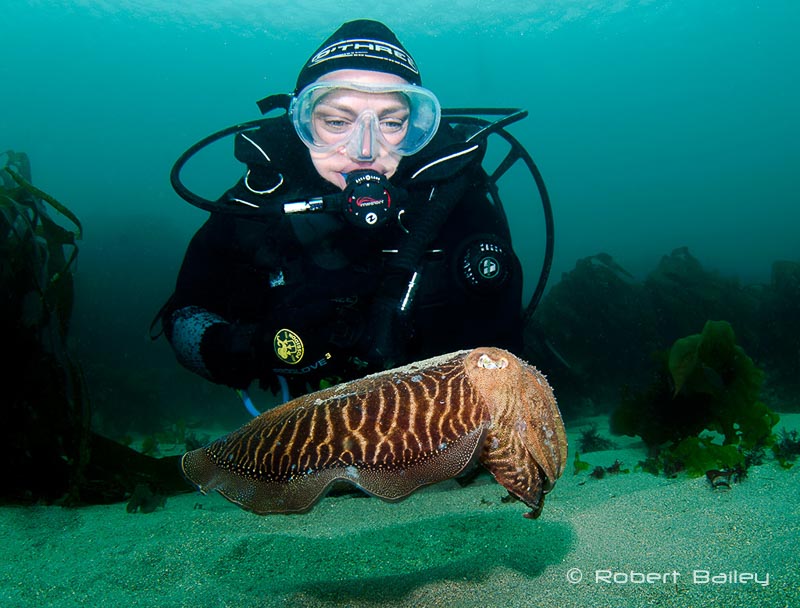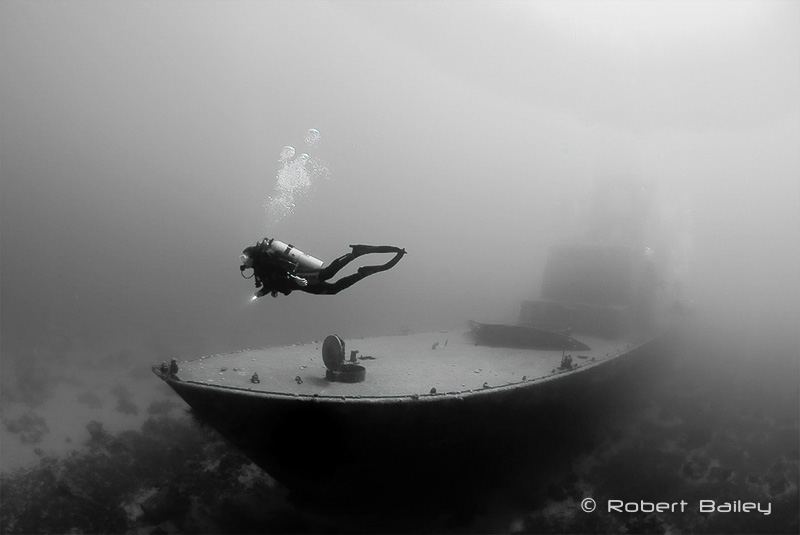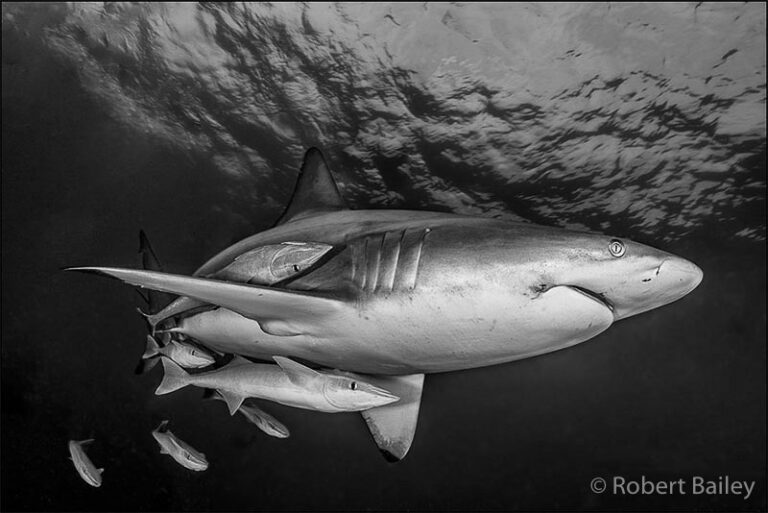
I was in London some years back listening to a presentation by David Doubilet. Being with the foremost underwater photographer in the world (at the time) you paid careful attention to every word. One thing that really stuck with me was his philosophy about underwater image making. His goal was to leave the viewer with a feeling of what it’s like being underwater. He likened being underwater to how an astronaut might feel in space. I’ve adopted that mind set ever since, and especially when I’m photographing models underwater.
We all have our own photographic styles. Many of us like to concentrate our efforts on marine life, big or small. I’m no different. Although the most evocative images I’ve seen over the years are pictures with models exploring deep wrecks, being approached by whales, under icebergs, and over beautiful reefs. Having a model in your shots lends scale to your images, and lets the viewer imagine what it might be like to be there.
I’ve been very lucky over the years to work with the same model, Paula Lindsay Bentley. A keen diver, and underwater photographer herself, she accompanied me on many photographic adventures, lectures, competitions, and award ceremonies. She understood what type of images win competitions, and became a very intuitive underwater model. We were a formidable team over the years, for which I’m very grateful. I think it’s important when working with a model, that you consider yourselves a team!
1.Photographic Intention?
What are you trying to achieve? My ideas come to fruition more often if I have a picture in my mind’s eye before I get in the water. Sharing your vision with your model is vital. Discuss your idea, draw it out on paper, look over similar images with your model before you jump in the water. This approach goes a long way to helping you get the shot you’ve been imagining. Your model will now have an image in her mind too. Discuss how you want your model to look in the picture, how to carry that dive light, and where to point it, what direction the sun is coming from, and where you’d like your model in relationship to it, etc, etc.

2.Communication
Articulating ideas can be difficult on the surface, let alone underwater. It’s crucial you go over what signals you’ll use, and what they mean before you get in the water. Be emphatic with your hand signals. Even when you can see your model, she might not be able to see you. Imagine you’re both wearing black gloves, you’re up against a blackish background, and you’re working in dim light. I’m speaking from experience here. Ensure your signals are clear and visible, and they are getting through to your model.

3. Where should my model be looking?
I ask my models to act natural, and to simply interact with the environment as if I wasn’t there. Generally, they should be looking at the main subject in the photograph, and avoid looking directly at the camera. Often I ask models to glance over my shoulder. If they’re holding a light I ask them to follow the beam visually.
4. Props and models
Props can be many things, more often than not it’s either a dive light, or a camera. Props help to add to the atmosphere in the image. If your model is diving with a camera, I ask that they keep their housing strobe arms tidy, and hold their rig comfortably at chest level, and direct attention to their potential subject. If they’re carrying a light I like a pencil thin beam, and one that doesn’t overpower the image. I ask models to point the beam where they are looking.
5. What should my model be wearing?
Let’s face it, divers can look quite unattractive underwater. This is especially true in cold water when they’ve donned a drysuit. I ask that my models do their best to look uncluttered. Tuck away dangling hoses, lights, computer straps, and put other bits in BC pockets, etc… This all helps your model appear more streamline. Modern equipment works best these days. I prefer to my models to wear masks with clear skirts to allow ambient light to seep through onto their faces.
6. Separate your subject from the background!
Separate your subject from the background. When we photograph models underwater we need to find a way to draw the viewer’s attention to the subject, and make them stand out from the background. This should be a primary goal for underwater photographers working with models. Images where the subject is attached to their surroundings can be uninteresting, and often lack impact.
There are many tricks we can incorporate to accomplish this. I ask my model to be conscious of where they are in relation to their environment, and to work to create a little negative space. Let your model have a look through the lens you’re going to be using. This helps them understand what you see. If feasible I often show my model the camera review screen so they get immediate feedback. An experienced model often looks for their own reflection in the dome port, and adjusts accordingly. Ultimately only you know when to fire the shutter, and I wait until I get subject separation. The same principle works well for bubble streams coming from the diver’s exhalation. I wait for the gap, then pull the trigger. You can see examples of both in the image below.

7. Near or Far? Where should I place my model?
This depends on what you’re doing, and the subjects you want to highlight in your image. Photographing your model from a distance as a silhouette is often easier on the model, and their facial expression is of no concern. Photographing models up close is more challenging. I ask models working up close to smile with their eyes, and stay focused on the subject. Experienced divers are generally relaxed, and often make great models.
8. How should models position themselves underwater?
I prefer to shoot models side on, and preferably have them gently finning through the scene. This keeps them fluid, and avoids static looking poses. I like to see models looking streamline. Some divers like to keep their lower legs facing up to avoid stirring up the bottom. I do understand that approach, but I’m not sure it looks that great in pictures, unless you’re cave diving. The picture below has models doing both, you decide which looks better. Often divers can end up looking messy underwater. I try to capture divers when they’re looking elegant.
9.Capturing interaction with marine life
I think these shots are fantastic, but they are not something that can be guaranteed. I am not an advocate of harassing, or harming marine life, or the environment they live in for the sake of a shot. As underwater photographers we are stewards of the environment. If the marine life wants to interact with you then that’s a bonus. Seals, and sea lions often fall into this category as they can be inquisitive. Some animals remain sessile on the bottom like scorpion fish. In those cases you still need to be mindful that you are in their space, and move very carefully ensuring not to cause the animal any stress.
10. Be kind to your model, and have fun.
Remember that models need to be willing to work with you before they pose. You should be cognizant that your model maybe struggling at times to help you get that shot. They could be fighting a current, struggling with their ears, or not able to understand what you are asking them to do. Pay attention, and ask them if they’re ok frequently. No shot is worth risking someone’s safety, enjoyment, or causing damage to the environment. Be thankful for their patience, and express your gratitude to them afterwards. Give credit in your images where possible to the model too. If you recall, you are a team. If things don’t go well, and even if they do, a debriefing will help you help in future. Remember above all to have fun. Often as photographers we get obsessed with our images, and forget why we got into the sport in the first place. Because we love marine life, and being underwater.
















